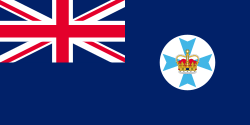 Queensland Separation Flag (St George's Cross with white border; different shade of blue) (1859) [4]
Queensland Separation Flag (St George's Cross with white border; different shade of blue) (1859) [4]
 | |
| Use | Civil and state flag |
|---|---|
| Proportion | 1:2 |
| Adopted | 1876 |
| Design | A British Blue Ensign defaced with the state badge on a white disc in the fly |

The state flag of Queensland is a British Blue Ensign with the state badge on a white disc added in the fly. The badge is a light blue Maltese cross with a Saint Edward's Crown in the centre of the cross. The flag dates from 1876, with minor variations, and the badge was designed by William Hemmant, the Colonial Secretary and Treasurer of Queensland in 1876. [1]











